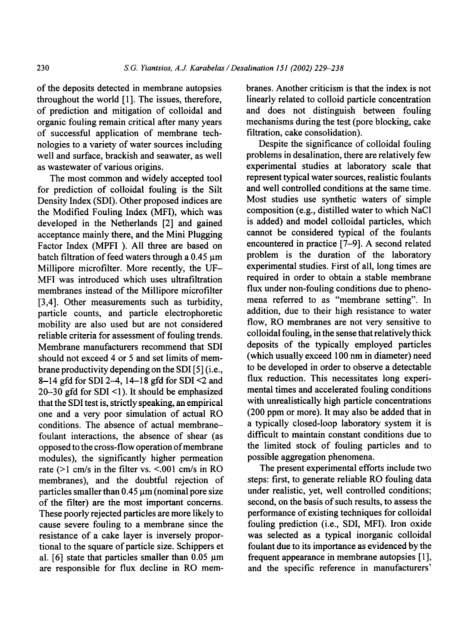An assessment of the Silt Density Index based on RO membrane ...
An assessment of the Silt Density Index based on RO membrane ...
An assessment of the Silt Density Index based on RO membrane ...
Create successful ePaper yourself
Turn your PDF publications into a flip-book with our unique Google optimized e-Paper software.
230 S. G. Yiantsios, A.J. Karabelas /Desalinati<strong>on</strong> 151 (2002) 229-238<br />
<str<strong>on</strong>g>of</str<strong>on</strong>g> <str<strong>on</strong>g>the</str<strong>on</strong>g> deposits detected in <strong>membrane</strong> autopsies<br />
throughout <str<strong>on</strong>g>the</str<strong>on</strong>g> world [l]. The issues, <str<strong>on</strong>g>the</str<strong>on</strong>g>refore,<br />
<str<strong>on</strong>g>of</str<strong>on</strong>g> predicti<strong>on</strong> and mitigati<strong>on</strong> <str<strong>on</strong>g>of</str<strong>on</strong>g> colloidal and<br />
organic fouling remain critical after many years<br />
<str<strong>on</strong>g>of</str<strong>on</strong>g> successful applicati<strong>on</strong> <str<strong>on</strong>g>of</str<strong>on</strong>g> <strong>membrane</strong> technologies<br />
to a variety <str<strong>on</strong>g>of</str<strong>on</strong>g> water sources including<br />
well and surface, brackish and seawater, as well<br />
as wastewater <str<strong>on</strong>g>of</str<strong>on</strong>g> various origins.<br />
The most comm<strong>on</strong> and widely accepted tool<br />
for predicti<strong>on</strong> <str<strong>on</strong>g>of</str<strong>on</strong>g> colloidal fouling is <str<strong>on</strong>g>the</str<strong>on</strong>g> <str<strong>on</strong>g>Silt</str<strong>on</strong>g><br />
<str<strong>on</strong>g>Density</str<strong>on</strong>g> <str<strong>on</strong>g>Index</str<strong>on</strong>g> (SDI). O<str<strong>on</strong>g>the</str<strong>on</strong>g>r proposed indices are<br />
<str<strong>on</strong>g>the</str<strong>on</strong>g> Modified Fouling <str<strong>on</strong>g>Index</str<strong>on</strong>g> (MFI), which was<br />
developed in <str<strong>on</strong>g>the</str<strong>on</strong>g> Ne<str<strong>on</strong>g>the</str<strong>on</strong>g>rlands [2] and gained<br />
acceptance mainly <str<strong>on</strong>g>the</str<strong>on</strong>g>re, and <str<strong>on</strong>g>the</str<strong>on</strong>g> Mini Plugging<br />
Factor <str<strong>on</strong>g>Index</str<strong>on</strong>g> (MPFI ). All three are <str<strong>on</strong>g>based</str<strong>on</strong>g> <strong>on</strong><br />
batch filtrati<strong>on</strong> <str<strong>on</strong>g>of</str<strong>on</strong>g> feed waters through a 0.45 pm<br />
Millipore micr<str<strong>on</strong>g>of</str<strong>on</strong>g>ilter. More recently, <str<strong>on</strong>g>the</str<strong>on</strong>g> UF-<br />
MFI was introduced which uses ultrafiltrati<strong>on</strong><br />
<strong>membrane</strong>s instead <str<strong>on</strong>g>of</str<strong>on</strong>g> <str<strong>on</strong>g>the</str<strong>on</strong>g> Millipore micr<str<strong>on</strong>g>of</str<strong>on</strong>g>ilter<br />
[3,4]. O<str<strong>on</strong>g>the</str<strong>on</strong>g>r measurements such as turbidity,<br />
particle counts, and particle electrophoretic<br />
mobility are also used but are not c<strong>on</strong>sidered<br />
reliable criteria for <str<strong>on</strong>g>assessment</str<strong>on</strong>g> <str<strong>on</strong>g>of</str<strong>on</strong>g> fouling trends.<br />
Membrane manufacturers recommend that SD1<br />
should not exceed 4 or 5 and set limits <str<strong>on</strong>g>of</str<strong>on</strong>g> <strong>membrane</strong><br />
productivity depending <strong>on</strong> <str<strong>on</strong>g>the</str<strong>on</strong>g> SD1 [5] (i.e.,<br />
8-14 gfd for SD1 2-4, 14-18 gfd for SD1 ~2 and<br />
20-30 gfd for SD1 cl). It should be emphasized<br />
that <str<strong>on</strong>g>the</str<strong>on</strong>g> SD1 test is, strictly speaking, an empirical<br />
<strong>on</strong>e and a very poor simulati<strong>on</strong> <str<strong>on</strong>g>of</str<strong>on</strong>g> actual <strong>RO</strong><br />
c<strong>on</strong>diti<strong>on</strong>s. The absence <str<strong>on</strong>g>of</str<strong>on</strong>g> actual <strong>membrane</strong>foulant<br />
interacti<strong>on</strong>s, <str<strong>on</strong>g>the</str<strong>on</strong>g> absence <str<strong>on</strong>g>of</str<strong>on</strong>g> shear (as<br />
opposed to <str<strong>on</strong>g>the</str<strong>on</strong>g> cross-flow operati<strong>on</strong> <str<strong>on</strong>g>of</str<strong>on</strong>g> <strong>membrane</strong><br />
modules), <str<strong>on</strong>g>the</str<strong>on</strong>g> significantly higher permeati<strong>on</strong><br />
rate (>l cm/s in <str<strong>on</strong>g>the</str<strong>on</strong>g> filter vs. c.001 cm/s in <strong>RO</strong><br />
<strong>membrane</strong>s), and <str<strong>on</strong>g>the</str<strong>on</strong>g> doubtful rejecti<strong>on</strong> <str<strong>on</strong>g>of</str<strong>on</strong>g><br />
particles smaller than 0.45 pm (nominal pore size<br />
<str<strong>on</strong>g>of</str<strong>on</strong>g> <str<strong>on</strong>g>the</str<strong>on</strong>g> filter) are <str<strong>on</strong>g>the</str<strong>on</strong>g> most important c<strong>on</strong>cerns.<br />
These poorly rejected particles are more likely to<br />
cause severe fouling to a <strong>membrane</strong> since <str<strong>on</strong>g>the</str<strong>on</strong>g><br />
resistance <str<strong>on</strong>g>of</str<strong>on</strong>g> a cake layer is inversely proporti<strong>on</strong>al<br />
to <str<strong>on</strong>g>the</str<strong>on</strong>g> square <str<strong>on</strong>g>of</str<strong>on</strong>g> particle size. Schippers et<br />
al. [6] state that particles smaller than 0.05 pm<br />
are resp<strong>on</strong>sible for flux decline in <strong>RO</strong> mem-<br />
branes. <str<strong>on</strong>g>An</str<strong>on</strong>g>o<str<strong>on</strong>g>the</str<strong>on</strong>g>r criticism is that <str<strong>on</strong>g>the</str<strong>on</strong>g> index is not<br />
linearly related to colloid particle c<strong>on</strong>centrati<strong>on</strong><br />
and does not distinguish between fouling<br />
mechanisms during <str<strong>on</strong>g>the</str<strong>on</strong>g> test (pore blocking, cake<br />
filtrati<strong>on</strong>, cake c<strong>on</strong>solidati<strong>on</strong>).<br />
Despite <str<strong>on</strong>g>the</str<strong>on</strong>g> significance <str<strong>on</strong>g>of</str<strong>on</strong>g> colloidal fouling<br />
problems in desalinati<strong>on</strong>, <str<strong>on</strong>g>the</str<strong>on</strong>g>re are relatively few<br />
experimental studies at laboratory scale that<br />
represent typical water sources, realistic foulants<br />
and well c<strong>on</strong>trolled c<strong>on</strong>diti<strong>on</strong>s at <str<strong>on</strong>g>the</str<strong>on</strong>g> same time.<br />
Most studies use syn<str<strong>on</strong>g>the</str<strong>on</strong>g>tic waters <str<strong>on</strong>g>of</str<strong>on</strong>g> simple<br />
compositi<strong>on</strong> (e.g., distilled water to which NaCl<br />
is added) and model colloidal particles, which<br />
cannot be c<strong>on</strong>sidered typical <str<strong>on</strong>g>of</str<strong>on</strong>g> <str<strong>on</strong>g>the</str<strong>on</strong>g> foulants<br />
encountered in practice [7-91. A sec<strong>on</strong>d related<br />
problem is <str<strong>on</strong>g>the</str<strong>on</strong>g> durati<strong>on</strong> <str<strong>on</strong>g>of</str<strong>on</strong>g> <str<strong>on</strong>g>the</str<strong>on</strong>g> laboratory<br />
experimental studies. First <str<strong>on</strong>g>of</str<strong>on</strong>g> all, l<strong>on</strong>g times are<br />
required in order to obtain a stable <strong>membrane</strong><br />
flux under n<strong>on</strong>-fouling c<strong>on</strong>diti<strong>on</strong>s due to phenomena<br />
referred to as “<strong>membrane</strong> setting”. In<br />
additi<strong>on</strong>, due to <str<strong>on</strong>g>the</str<strong>on</strong>g>ir high resistance to water<br />
flow, <strong>RO</strong> <strong>membrane</strong>s are not very sensitive to<br />
colloidal fouling, in <str<strong>on</strong>g>the</str<strong>on</strong>g> sense that relatively thick<br />
deposits <str<strong>on</strong>g>of</str<strong>on</strong>g> <str<strong>on</strong>g>the</str<strong>on</strong>g> typically employed particles<br />
(which usually exceed 100 nm in diameter) need<br />
to be developed in order to observe a detectable<br />
flux reducti<strong>on</strong>. This necessitates l<strong>on</strong>g experimental<br />
times and accelerated fouling c<strong>on</strong>diti<strong>on</strong>s<br />
with unrealistically high particle c<strong>on</strong>centrati<strong>on</strong>s<br />
(200 ppm or more). It may also be added that in<br />
a typically closed-loop laboratory system it is<br />
difficult to maintain c<strong>on</strong>stant c<strong>on</strong>diti<strong>on</strong>s due to<br />
<str<strong>on</strong>g>the</str<strong>on</strong>g> limited stock <str<strong>on</strong>g>of</str<strong>on</strong>g> fouling particles and to<br />
possible aggregati<strong>on</strong> phenomena.<br />
The present experimental efforts include two<br />
steps: first, to generate reliable <strong>RO</strong> fouling data<br />
under realistic, yet, well c<strong>on</strong>trolled c<strong>on</strong>diti<strong>on</strong>s;<br />
sec<strong>on</strong>d, <strong>on</strong> <str<strong>on</strong>g>the</str<strong>on</strong>g> basis <str<strong>on</strong>g>of</str<strong>on</strong>g> such results, to assess <str<strong>on</strong>g>the</str<strong>on</strong>g><br />
performance <str<strong>on</strong>g>of</str<strong>on</strong>g> existing techniques for colloidal<br />
fouling predicti<strong>on</strong> (i.e., SDI, MFI). Ir<strong>on</strong> oxide<br />
was selected as a typical inorganic colloidal<br />
foulant due to its importance as evidenced by <str<strong>on</strong>g>the</str<strong>on</strong>g><br />
frequent appearance in <strong>membrane</strong> autopsies [ 11,<br />
and <str<strong>on</strong>g>the</str<strong>on</strong>g> specific reference in manufacturers’

















